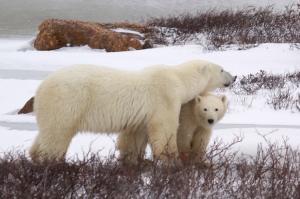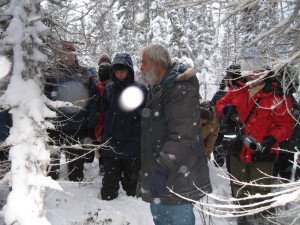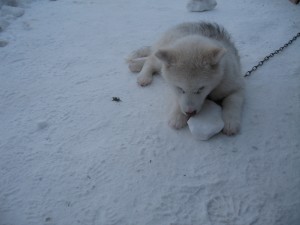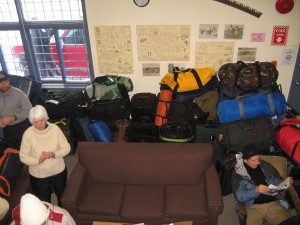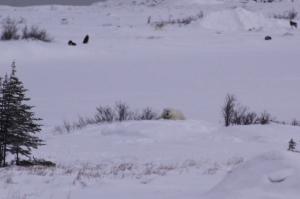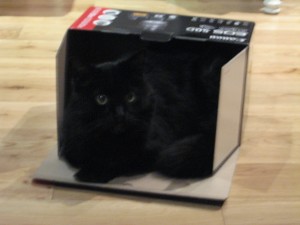November 11, 2010
We woke up this morning to snow! Considering we’re in the Arctic, that shouldn’t be surprising nor cause for celebration, but the weather has been unseasonably warm for this time of year and that’s not ideal for the bears, so dropping temperatures and snow are a welcome relief.
The longer it takes for the ice to freeze, the longer the bears must wait to get the nourishment they need for the coming year. Earlier today, I was told that a beluga whale washed ashore this summer and that several bears fed off the whale, so they are in better shape than usual for this time of year. That said, others are not faring well.
Depending on the length of time until the ice freezes, some bears won’t survive long enough to go out and hunt once the ice does freeze – the last time these bears ate was sometime early in the summer. This delayed freeze also necessitates that smaller bears, moms and cubs stay a safe distance away from large male bears whom pose a threat of potential cannibalism.
I’ve learned a lot during the past 2 days. Some of it fascinating, some of it disturbing, and much of it leaves me feeling conflicted.
Look at this picture (click thumbnail to enlarge):
 Polar bears have become the icon for climate change issues and I understand why. If you think they’re “cute” or otherwise spectacular in pictures, that’s nothing compared to how exquisite they are in person.
Polar bears have become the icon for climate change issues and I understand why. If you think they’re “cute” or otherwise spectacular in pictures, that’s nothing compared to how exquisite they are in person.
Polar bears are strong, powerful, playful, tender, clever, and brave. At the same time, polar bears are exceptionally vulnerable. One “bad year” for polar bears can decrease their population significantly. As it stands, the polar bear population is on a steady decline, even during “good years.” Some biologists estimate that, if things continue the way they’re going, we could have an ice-free Arctic within 40 years. In some Arctic regions, this could occur within the next 20 years.
Some effects of climate change that I’ve witnessed during my 3 visits to Churchill are:
• The ice is freezing later and later each season. This year, it’s already approximately 1 month later than the historical average for the ice to freeze, and it hasn’t frozen yet
• “Warm” temperatures and minimal snow on the ground in early November 2010
• An obvious decline in 2010 population of Arctic Fox due to lack of food source (lemmings) this year. We haven’t seen any Arctic Fox this year. People who have been here all season say they’ve seen very few Arctic Fox.
• Not as many bear sightings as previous years
• Bears with a lesser average weight than normal. Low body weight leads to population decline. i.e. Sows can’t get pregnant if they don’t weigh enough.
Being here in Churchill with the bears leaves me with the nagging question: Now that we’ve used polar bears to get people’s attention, who is protecting the bears?
The gift Churchill provides is that it offers an opportunity for people to witness polar bears in their natural habitat. This is important because when people observe the polar bears of Churchill, they have a tendency to talk about it. The messages and photos that reinforce the iconic use of the polar bear as a mascot for climate change are spread to mass consciousness as more and more people experience Churchill for themselves.
The power of these conversations and the sharing of information and experiences among friends, colleagues, families, and media is undeniable. I began this blog 3 years ago precisely so I could document these experiences and I’ve already been interviewed by journalists and by an author of a forthcoming book about polar bears.
There are also serious downfalls as a result of the success of polar bear tourism in Churchill. The main downfall is the impact the exploitation of this industry is having on the bears. During the course of this week alone I have witnessed:
• Photographers in vehicles chasing bears to various locations to obtain a desired photo. This is highly stressful to the bears and causes them to burn calories they need to be conserving until they can go out on the ice and hunt (photo by: Alan Watson)
• Private tour providers in vehicles physically “bumping” bears with cars
• Bears running toward staff vehicles of specific tour operators, signaling they’ve experienced some form of impact from people in these specific vehicles. They’re running up to the vehicles, not from them, which likely indicates they’ve received some reward (i.e. food) from people in these automobiles
•Photographers getting out of their cars and approaching bears within a few feet to get photos. You may think to yourself, “Well, if that idiot gets killed by a bear, that’s his own fault.” Yes, but if that idiot gets killed by a bear, then the bear also gets killed. So in the end, the bear still loses. (photo by: Alan Watson)
• Bears surrounded by cars, therefore unable to continue on their path (photo by: Alan Watson)
• Tundra buggy tracks leading off course, including one that appeared as if someone had done donuts in a buggy, on the tundra
• Tour operators with open food in close proximity of bears, so that the smell will lure the bears even closer to the vehicle/customers
• Tourists clapping and yelling at bears to “get their attention” or try to get them to come closer. This is happening on guided tours, with guides who should educate rather than tolerate this.
• Human food conditioning of bears (bears learning they can get food from people or as a result of people). i.e. enabling bears to eat “dog food” at a residence that also allows private tours on their property for published fees ranging from $500-$1,000 per person, per day
• Last year, we saw a photographer in a truck chase a bear into the water so that he could capture a picture of the bear swimming
The bear viewing industry in Churchill is having an obvious impact on the bears.
Is it possible for people to be in close proximity of bears, without impact? There are definitely examples, such as the managed wildlife program at McNeil River, where if there is an impact, it’s absolutely imperceptible. I was fortunate enough to win the McNeil lottery this year and was able to visit the park that has the highest concentration of brown bears in the world.
The program at McNeil River is highly managed, educates people thoroughly to ensure the bears do not experience any impact – positive/reward or negative/fear from visitors. You can only get into the program by winning a random lottery. 10 people are allowed into the park at a time, in 4-day sessions. In my opinion, McNeil River is the epitomizing example of peaceful co-existence between different species. I believe the keys to the success of this program are restricted access, education, consistency, and respect. I will write a separate story about McNeil River soon.
Unfortunately, in Churchill, it’s likely too late for a program like the one at McNeil to be effective. Churchill bears are already conditioned to the impact visitors have had on them over time. They associate people with food and fear – reward and punishment. The program at McNeil was established more than 30 years ago and has been in affect since the first day visitors were allowed in the park.
There are several things that should be done on a global level, as well as numerous things that can be done in Churchill to help protect the bears. There is certainly some legislation that could be instituted and enforced on a local level. However, Churchill is a very small town and there are a lot of politics involved within the community that make this a challenge. Tour operations should be better regulated, tour operators better informed. But, again – even the “best” tour groups in Churchill have illustrated some intentional negative impact on the bears. Plus, “polar bear tourism” is one of only 3 primary sources of revenue in the small town. Therefore, implementing anything that is perceived as a threat to the viability of the business, likely won’t pass. As a result, these operations are creating an additional threat to the viability of polar bears.
There are plenty of people focusing on the “problems” and what we “can’t do.” So what can we do?
I do not claim to be an expert on this – these are merely my recommendations based on what I’ve learned and my experiences in Churchill for the past 3 years.
If you have plans to or would like to visit Churchill:
- Consider traveling with either The Great Bear Foundation with Chuck Jonkel or Ursus International with Rupert Pilkington. A lot of people come to Churchill on their own and arrange tours within Churchill themselves. From the math I’ve done, there doesn’t seem to be a financial benefit to this. More important, if you travel with one of these 2 organized groups, you are participating in an actual field course that includes education and experiential learning. What does this mean? Well, instead of counting how many bears you saw, you’ll be learning about the behaviors of the bears you’ve witnessed, Arctic ecology, Inuit culture, and what you can do to help preserve Arctic ecology.
- Seek out a holistic education about the Arctic including: Arctic ecology, the people and communities, history, the Northwest Passage, sources of income, and of course, polar bears
- Integrate the knowledge you’ve acquired through your experiences in Churchill
- When in Churchill, support the following businesses:
- The Eskimo Museum – a wonderful Inuit museum with great gift shop. The money from sales here goes directly back into the community
- The Northern Store – the one and only (grocery/convenience) store in Churchill open year-round. They also provide a lot of jobs for locals
- Northern Images – retail arm of Canadian co-ops limited. Revenue from sales here goes back to co-op. Everyone in the community is a member of co-op and they receive their dividends just in time for Christmas
- Wapusk – owned by Churchill locals who are in town year-round. They also run a dog sled tour business
- Do not feed the bears nor try to lure them over with any kind of food
- Do not approach bears
- If you see behavior that is harmful to the animals (i.e. baiting bears with food, harassing bears with vehicles, speeding up or taking “short cuts” to see a bear by chasing after it on a tundra buggy, etc) or Arctic ecology (i.e. destroying the tundra by driving tundra buggies off established paths), DOCUMENT IT. Take pictures or video. You should try to report it to local authorities in Churchill, but don’t stop there. Take the story outside of Churchill. Global attention and support will likely be more effective in facilitating a positive change than keeping it local.
- Do NOT visit Brian Ladoon’s “sled dog” property
- If you do decide to go on a tundra buggy, please request JP as your guide on Frontiers North Tundra Buggy Adventures. I rode with JP 2 years in a row – he stays on the path, he’s a great interpreter (you’ll learn more about the bears), he doesn’t put the buggy in the way of the path a bear is walking, he ensures passengers are respectful and quiet around the bears, he stays away from bears that seem distressed. Unfortunately, I can’t say the same for other guides I’ve had. It’s worth waiting for JP’s availability or not going out on a tundra buggy at all
Tour operators want you to have a good time; they want you to see a lot of bears. You will pay a considerable amount of money for this experience and it’s important that it doesn’t happen at the expense of the well-being of polar bears. Come to Churchill to support them, not to participate in their demise.
The amount of negative impact this experience can have on the bears is up to you. If a tour operator is doing any of the following things, it is NOT ok:
- Baiting bears to a location or vehicle with food or food smells (opening food containers near bears)
- Allowing passengers to clap at and yell to the bears to try to “get their attention” or get them to come closer
- Obstructing or intersecting the path/course a polar bear is walking
- Chasing after polar bears
- Getting out of the vehicle in close proximity to the bears
- Tundra buggy drivers driving off the designated course and established paths
Not everyone will be able to see polar bears in Churchill, so here are some things you can do to help, no matter where you live:
- Here are some simple, easy, things you can do to minimize your carbon footprint from Polar Bears International and Stop Global Warming
- If you’re looking to support an organization that provides year-round education and implementation of programs that support and protect wildlife, I highly recommend Greatbear.org.
- Learn as much as you can about current and pending legislation re: climate change, oil drilling, wildlife protection. Know who your state and local representatives are so you can reach out to them about these issues
- Help me take this story global — we need international support to protect the bears. I can be reached at: colette@mytraveltales.com
These guys are counting on US:














